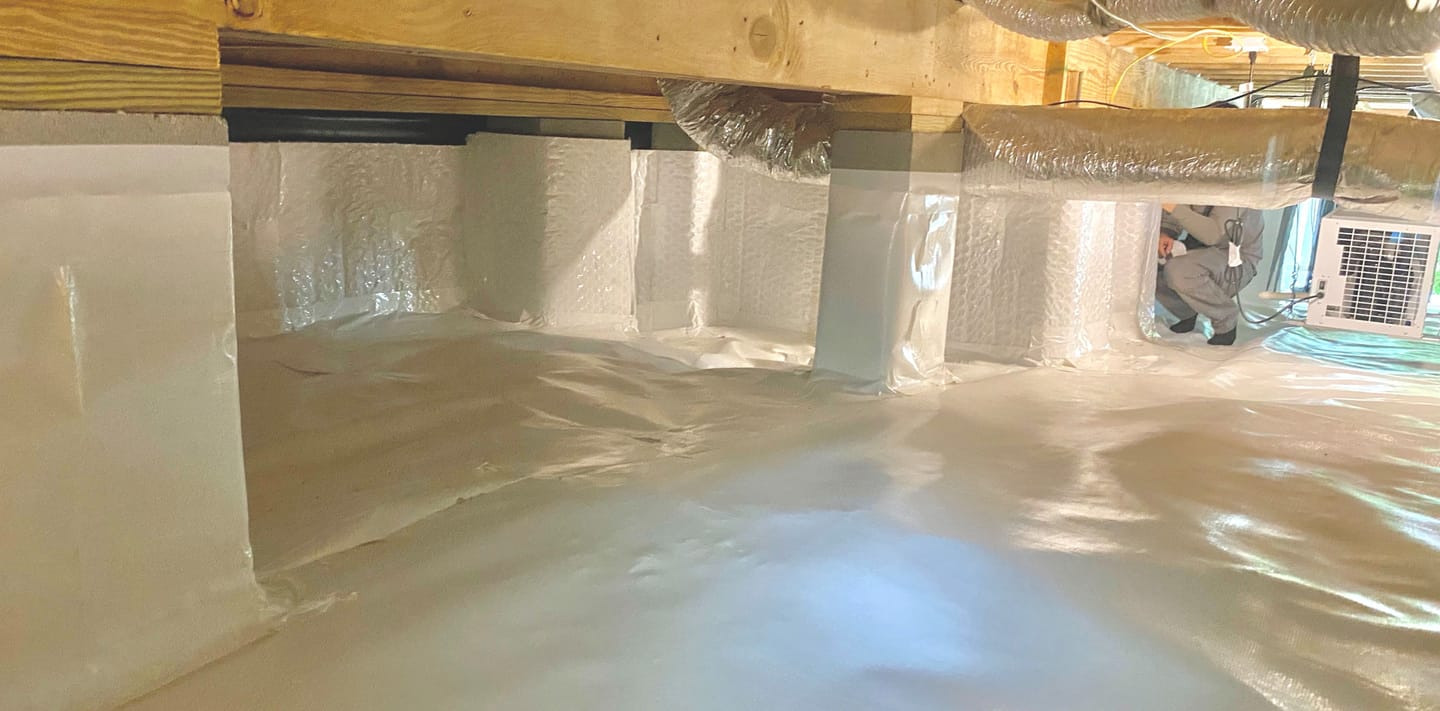Imagine stepping into your home, expecting the usual comfort, only to be greeted by a musty odor wafting from below. That’s when it hits you: the forgotten realm beneath your feet – the crawl space. It’s not just an empty void; it harbors secrets crucial for your home’s health and air quality. A lot of homeowners tend to miss this sneaky spot until they’re smack dab in the middle of a problem. But here’s a twist: what if I told you that managing your crawl space could transform it from a problem zone into one of the pillars of your home’s wellness?
The changes we’ve seen have been nothing short of amazing. From being merely an afterthought in construction plans to now, where sophisticated solutions like vapor barriers and encapsulation techniques promise to shield our homes against moisture, mold, and even pests. Yet, despite advancements, many still tread lightly around crawl space care.
Why? Well, myths abound and facts can sometimes get buried under layers of misinformation or neglect. Did you know that effectively managed crawl spaces can significantly impact indoor air quality? Yes! The very air we breathe in our homes can be cleaner and healthier if we give our crawl spaces the attention they deserve. So, let’s start paying more attention to these often-neglected areas for the sake of our health.
The Evolution of Crawl Spaces in American Homes
Crawl spaces have been a popular choice in American homes since the 19th century. But it wasn’t until the 1940s and 1950s that they really gained traction, thanks to decreased construction costs.
The first building codes recommended ventilating crawl spaces and installing vapor barriers to address moisture issues. But as we’ve learned more about crawl space science, our approach has evolved.
Today, we know that ventilated crawl spaces can actually make moisture problems worse. That’s why many homeowners are now opting for sealed crawl spaces instead.
Ventilated vs. Sealed Crawl Spaces
So what’s the difference between ventilated and sealed crawl spaces? And how do they impact your home’s health? Let’s take a closer look.
Benefits of Ventilated Crawl Spaces
Ventilated crawl spaces work by allowing outside air to circulate through the space, which can help reduce soil gases and control moisture levels. The idea is that by bringing in fresh air, you can prevent stagnant, humid conditions that lead to mold and wood rot.
But here’s the problem: ventilated crawl spaces can actually make indoor air quality worse. That’s because they allow outside pollutants, allergens, and moisture into your home. Plus, if the vents are improperly sized or located, they can create “dead zones” where air doesn’t circulate properly.
Transitioning to Sealed Crawl Spaces
That’s why many experts now recommend sealing crawl spaces instead. A sealed crawl space is completely enclosed, with no vents to the outside. This creates a controlled environment that’s easier to keep dry and free of contaminants.
Sealing your crawl space can also improve your home’s energy efficiency by preventing outside air from entering the space. This can help reduce your heating and cooling costs, while also making your home more comfortable year-round.
Importance of Vapor Barriers in Crawl Spaces
Whether you have a ventilated or sealed crawl space, a vapor barrier is essential for protecting your home from moisture damage. A vapor barrier is a thick plastic sheet that covers the ground in your crawl space, preventing moisture from seeping up into your home.
Installation Techniques for Vapor Barriers
To be effective, vapor barriers need to be installed properly. That means covering the entire ground surface, including any piers or columns. The barrier should also extend up the foundation walls by at least 6 inches.
It’s important to use a high-quality, durable vapor barrier that’s at least 6 mil thick. Some contractors even recommend using a 10 or 20 mil barrier for extra protection. And be sure to seal any seams or edges with tape to create a continuous barrier.
Advanced Solutions for Crawl Space Moisture Control
Besides vapor barriers, there are plenty of other nifty tools and tricks out there to help you keep your crawl space nice and dry. One popular option is crawl space encapsulation.
Encapsulated Crawl Space Technology
Encapsulation involves completely sealing the crawl space with a heavy-duty vapor barrier, then installing a dehumidifier to control moisture levels. This creates a clean, dry environment that’s inhospitable to mold, pests, and other contaminants.
Encapsulation can also improve your home’s air quality by preventing musty odors and allergens from entering your living space. And because the crawl space is sealed, you don’t have to worry about outside air affecting your energy bills.
Addressing Drainage Problems in Crawl Spaces
Of course, even the best moisture control solutions won’t work if you have drainage problems around your foundation. That’s why it’s important to make sure your gutters, downspouts, and grading are all working properly to direct water away from your home.
Innovative Drainage Solutions
If you do have drainage issues, there are some innovative solutions that can help. For example, installing a French drain system around the perimeter of your foundation can intercept water before it has a chance to enter your crawl space.
Another option is to install a sump pump in your crawl space to remove any water that does get in. Just be sure to choose a high-quality pump with a reliable float switch and backup battery in case of power outages.
The Role of Insulation in Crawl Space Health
Insulation is another important factor in maintaining a healthy crawl space. Getting the right insulation can work wonders by keeping your home’s temperature just where you want it, slashing those pesky energy bills, and stopping that annoying condensation in its tracks before mold even thinks about growing.
Types of Insulation Suitable for Crawl Spaces
There are several types of insulation that can be used in crawl spaces, including fiberglass batts, spray foam, and rigid foam board. Each has its own pros and cons in terms of cost, ease of installation, and moisture resistance.
Generally speaking, spray foam and rigid foam board are the best options for crawl spaces because they provide a seamless air and moisture barrier. But fiberglass batts can also work well if they’re properly installed and protected with a vapor barrier.
Preventing Wood Rot and Biofilm Contaminants in Crawl Spaces
Moisture isn’t the only threat to your crawl space – wood rot and biofilm contaminants can also cause serious damage over time. Fungi, the sneaky culprits behind wood rot, absolutely love hanging out in damp spots with not much air moving through. Biofilm is like that sticky, slimy layer you sometimes find on surfaces – it’s not just unpleasant to the touch; it can also be a cozy home for mold, bacteria, and various other tiny critters.
Regular Maintenance and Inspection Tips
To prevent these issues, it’s important to keep your crawl space clean and well-maintained. That means removing any debris or organic material that could harbor moisture or pests. This also involves keeping an eye on your crawl space to catch any tell-tale signs of water sneaking in, like unexpected puddles, wet insulation, or that unmistakable musty smell.
If you do notice any problems, it’s important to address them right away before they have a chance to spread. A professional crawl space contractor can help assess the situation and recommend the best course of action.
Enhancing Air Quality with Crawl Space Solutions
Finally, let’s talk about how proper crawl space management can improve your home’s overall air quality. Many people don’t realize that the air in their crawl space can actually circulate up into their living space through a process called the “stack effect.”
The Impact of Sealed Crawl Spaces on Indoor Air Quality
So, it turns out that sealing your crawl space can really shake things up for the better when we’re talking about the air quality inside your home. By preventing outside air, moisture, and contaminants from entering the space, you can create a healthier environment for your family.
Sealing your crawl space isn’t just about keeping out the damp; it’s a smart move for cutting down on pesky allergens like dust mites, mold spores, and pollen that love to mess with our breathing. And because the air is cleaner and drier, you may even notice fewer musty odors in your home.
Transform your home’s health and comfort by switching from ventilated to sealed crawl spaces. Sealed spaces improve air quality, cut energy costs, and protect against moisture damage.
Conclusion
So, here we are at the end of our journey through the hidden world beneath our feet – crawl spaces. It’s been quite the adventure, hasn’t it? We’ve dug into their past to find out where they came from and have looked at the cool, modern ways we keep them dry and feeling good. Who knew this often-overlooked area could hold so much power over our home’s wellness and air quality?
We’ve debunked myths, embraced facts, and discovered how ventilated or sealed, with vapor barriers or full encapsulation, each strategy plays its part in transforming a potential problem zone into a pillar of home health. The evolution from mere afterthoughts to critical aspects of construction showcases not just innovation but necessity.
The truth is as clear as day: managing your crawl space isn’t about fearing what lurks below; it’s about recognizing its impact above. Just like AI quietly revolutionizes our daily lives without heralding doom, properly cared-for crawl spaces silently enhance our living environment – making homes safer, air cleaner, and ultimately lives better.
So, this goes way beyond just keeping moisture or critters at bay; think of it as a continuous promise to protect the place you call home. And while Hollywood might have us believe otherwise in tales of AI gone rogue, remember – when armed with knowledge and the right tools for care – even something as seemingly mundane as a crawl space can become a hero in its own right.


